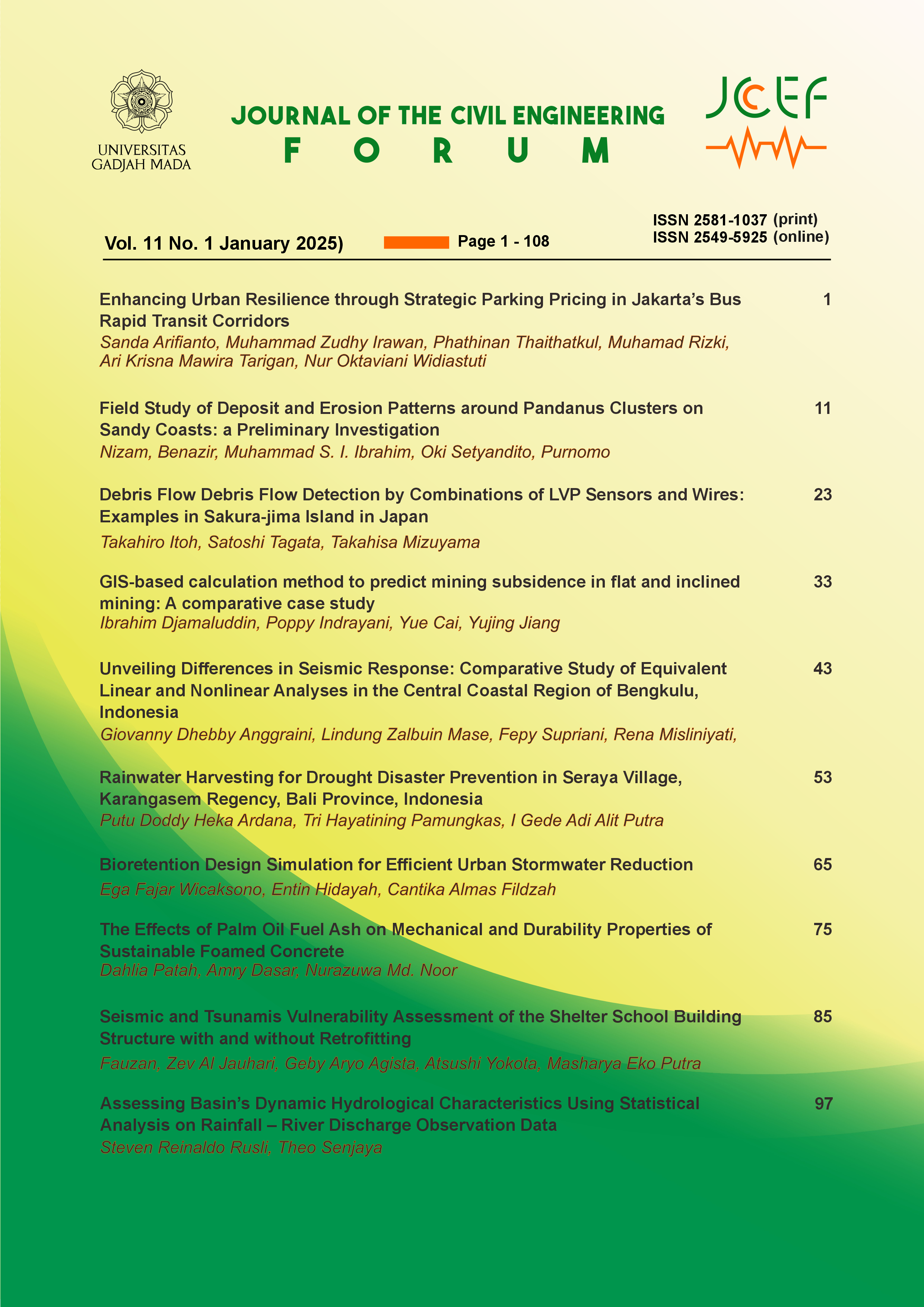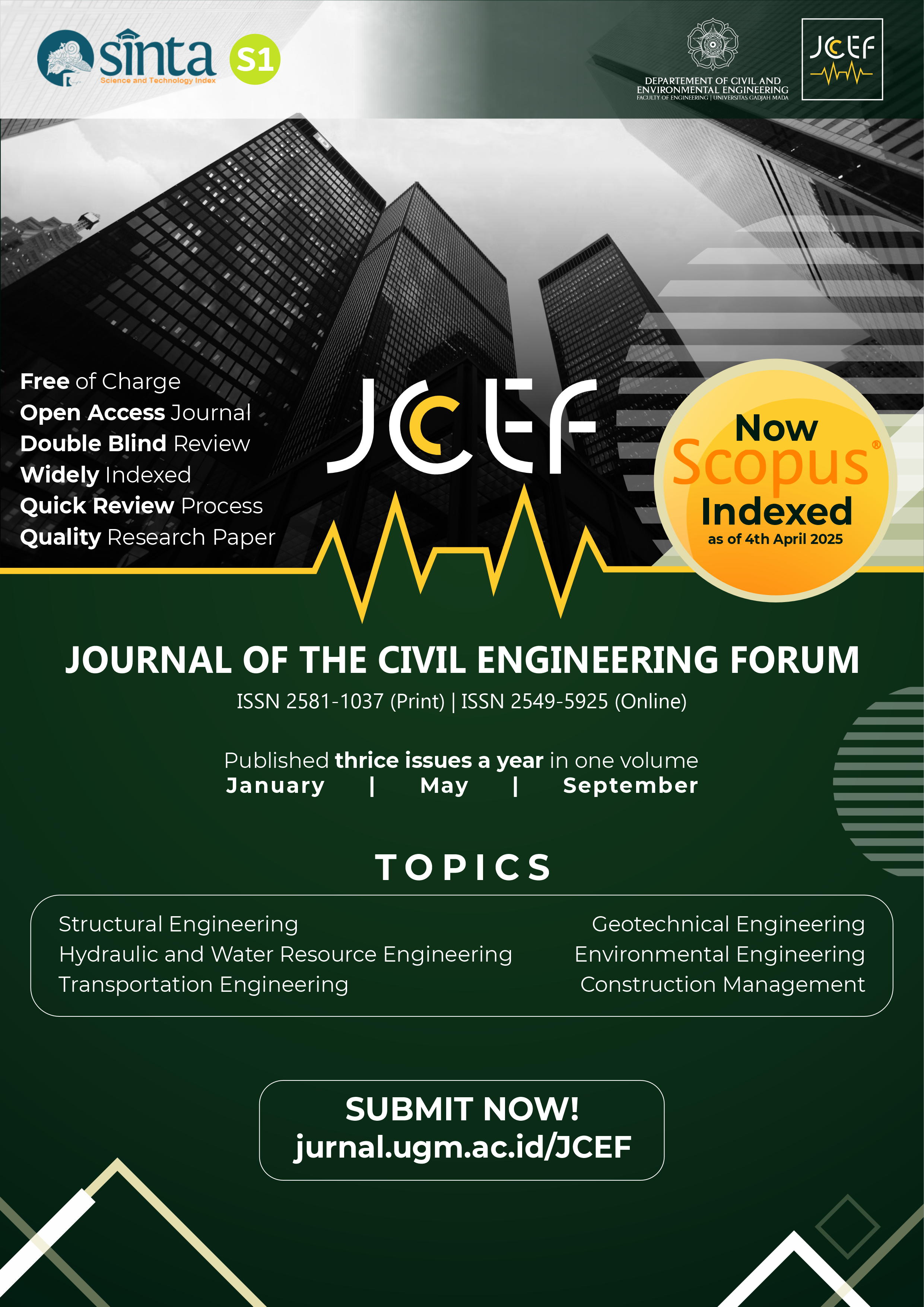Enhancing Urban Resilience through Strategic Parking Pricing in Jakarta’s Bus Rapid Transit Corridors
Abstract
Although Jakarta has invested in various mass transport systems, these efforts have not successfully reduced private vehicle use. Due to this, this study aims to analyze the impact of implementing TransJakarta bus rapid transit corridor-based high parking tariffs on travel mode choice, including road- and rail-based public transport, ride-hailing, taxi, car, and motorcycle. Involving 478 private vehicle users and implementing a nested logit model, some variables, including respondents’ income, travel time, egress time, parking costs, parking distance, travel cost, and parking surcharge, are considered to understand to what extent these variables influence the use of proposed travel mode in the future. The nested logit model shows that not all variables significantly influence travel mode use, specifically related to rail-based public transport choice among motorcyclists. Meanwhile,
parking distance insignificantly influences the choice of all travel modes except cars among car users. The results also indicate that increasing parking tariffs insignificantly influences the likelihood of both motorcyclists and car users shifting to public transport. Motorcyclists and car users tend to continue using motorcycles but change parking locations with higher tariffs. Additionally, some shifts towards ride-hailing services and TransJakarta Bus Rapid Transit are found, meaning that there is potential for these alternatives to play a significant role in reducing private vehicle use. Based on the model results, additional push-based policies, such as the odd-even license plate rule, are necessary to effectively support the transition from private vehicle use to public transport. Implementing these policies is expected to significantly contribute to reducing traffic congestion and promoting a sustainable and resilient urban environment.
References
Agarwal, S., Koo, K.M., 2016. Impact of electronic road pricing (ERP) changes on transport modal choice. Regional Science and Urban Economics 60, 1–11. https://doi.org/10.1016/J.REGSCIURBECO.2016.05.003
Ahmadi Azari, K., Arintono, S., Hamid, H., Rahmat, R.A.O.K., 2013. Modelling demand under parking and cordon pricing policy. Transport Policy 25, 1–9. https://doi.org/10.1016/J.TRANPOL.2012.10.003
Arnott, R., Inci, E., Rowse, J., 2015. Downtown curbside parking capacity. Journal of Urban Economics 86, 83–97. https://doi.org/10.1016/J.JUE.2014.12.005
Arnott, R., Rowse, J., 2009. Downtown parking in auto city. Regional Science and Urban Economics 39, 1–14. https://doi.org/10.1016/J.REGSCIURBECO.2008.08.001
Bastarianto, F.F., Irawan, M.Z., Choudhury, C., Palma, D., Muthohar, I., 2019. A Tour-Based Mode Choice Model for Commuters in Indonesia. Sustainability 11, 1–20. https://doi.org/10.3390/SU11030788
Belgiawan, P.F., Ilahi, A., Axhausen, K.W., 2019. Influence of pricing on mode choice decision in Jakarta: A random regret minimization model. Case Studies on Transport Policy 7, 87–95. https://doi.org/10.1016/J.CSTP.2018.12.002
Berawi, M.A., Saroji, G., Iskandar, F.A., Ibrahim, B.E., Miraj, P., Sari, M., 2020. Optimizing Land Use Allocation of Transit-Oriented Development (TOD) to Generate Maximum Ridership. Sustainability. https://doi.org/10.3390/su12093798
Brown, B., 1986. Modal choice, location demand, and income. Journal of Urban Economics 20, 128–139. https://doi.org/10.1016/0094-1190(86)90002-1
Chaniotakis, E., Pel, A.J., 2015. Drivers’ parking location choice under uncertain parking availability and search times: A stated preference experiment. Transportation Research Part A: Policy and Practice 82, 228–239. https://doi.org/10.1016/J.TRA.2015.10.004
Chatman, D.G., Manville, M., 2018. Equity in Congestion-priced Parking. Journal of Transport Economics and Policy 52, 239–266.
Chiu, B., 2022. Case Studies on Transport Policy Does the bus rapid transit reduce motorcycle use ? Evidence from the Jakarta metropolitan area , Indonesia. Case Studies on Transport Policy. https://doi.org/10.1016/j.cstp.2022.07.007
Dahlan, A.F., Fraszczyk, A., 2019. Public Perceptions of a New MRT Service: a Pre-launch Study in Jakarta. Urban Rail Transit 5, 278–288. https://doi.org/10.1007/s40864-019-00116-0
Dirgahayani, P., Yesuari, A.P., Wulansari, T.R., Sutanto, H., 2020. The formation of network governance in accelerating the implementation of TOD: The case of Jakarta MRT Phase 1, Indonesia. Case Studies on Transport Policy 8, 1412–1425. https://doi.org/10.1016/J.CSTP.2020.10.006
Fosgerau, M., de Palma, A., 2013. The dynamics of urban traffic congestion and the price of parking. Journal of Public Economics 105, 106–115. https://doi.org/10.1016/J.JPUBECO.2013.06.008
Golias, J., Yannis, G., Harvatis, M., 2002. Off-Street Parking Choice Sensitivity. Transportation Planning and Technology 25, 333–348. https://doi.org/10.1080/0308106022000019620
Governor of DKI Jakarta Province, 2016. Governor Regulation on Odd-Even License Plate Area, Governor Regulation 164/2016, Jakarta (in Indonesia).
Governor of DKI Jakarta Province, 2012. Governor Regulation on Traffic Control Area, Governor Regulation 110/2012, Jakarta (in Indonesian).
Hanna, R., Kreindler, G., Olken, B.A., 2017. Citywide effects of high-occupancy vehicle restrictions: Evidence from “three-in-one” in Jakarta. Science 357, 89–93. https://doi.org/10.1126/science.aan2747
Hansen, S., Too, E., Le, T., 2018. Lessons Learned from a Cancelled Urban Transport Project in a Developing Country: The Importance of the Front-end Planning Phase. International Journal of Technology 9, 291–319. https://doi.org/https://doi.org/10.14716/ijtech.v9i5.1559
Henao, A., Marshall, W.E., 2019. The impact of ride hailing on parking (and vice versa). Journal of Transport and Land Use 12, 127–147. https://doi.org/http://dx.doi.org/10.5198/jtlu.2019.1392
Hess, D.B., 2001. Effect of Free Parking on Commuter Mode Choice: Evidence from Travel Diary Data. Transportation Research Record 1753, 35–42. https://doi.org/10.3141/1753-05
Ilavarasan, V., Verma, R.K., Kar, A.K., 2018. Sharing Economy Platforms as enablers of urban transport in the Global South: Case of digital taxi aggregators in New Delhi, India. In: CIPPEC Urban Transport in the Sharing Economy Era: Collaborative Cities. Buenos Aires.
Indonesia Bureau of Statistics, 2022. Statistical Yearbook of Indonesia 2021 [WWW Document]. URL https://www.bps.go.id/publication/2021/02/26/938316574c78772f27e9b477/statistik-indonesia-2021.html (accessed 8.24.22).
Irawan, M.Z., Belgiawan, P.F., 2022. Ride-hailing app use for same-day delivery services of foods and groceries during the implementation of social activity restrictions in Indonesia. International Journal of Transportation Science and Technology In Press. https://doi.org/10.1016/j.ijtst.2022.03.004
Irawan, M.Z., Belgiawan, P.F., Tarigan, A.K.M., Wijanarko, F., 2020. To compete or not compete: exploring the relationships between motorcycle-based ride-sourcing, motorcycle taxis, and public transport in the Jakarta metropolitan area. Transportation 47, 2367–2389. https://doi.org/10.1007/s11116-019-10019-5
Jabodetabek Transportation Management Agency, 2019. Masterplan of Jabodetabek Transportation [WWW Document]. URL http://bptj.dephub.go.id/rencana- induk-transportasi-jabodetabek-ritj. (accessed 8.24.22).
Jakarta Statistics Agency, 2022. Jakarta in Figure 2022 [WWW Document]. URL https://jakarta.bps.go.id/ (accessed 8.25.22).
Kirschner, F., Lanzendorf, M., 2020. Parking management for promoting sustainable transport in urban neighbourhoods. A review of existing policies and challenges from a German perspective. Transport Reviews 40, 54–75. https://doi.org/10.1080/01441647.2019.1666929
Liu, M., Wronski, L., 2018. Trap questions in online surveys: Results from three web survey experiments. International Journal of Market Research 60, 32–49. https://doi.org/10.1177/1470785317744856
Loilatu, M.J., Mutiarin, D., Nurmandi, A., Sulistyaningsih, T., Salahudin, 2021. Smart Mobility: How Jakarta’s Developing Sustainable Transportation to Connect the Community BT - HCI International 2021 - Late Breaking Posters, in: Stephanidis, C., Antona, M., Ntoa, S. (Eds.), . Springer International Publishing, Cham, pp. 543–551.
Mandle, P., Box, S., 2017. Transportation network companies: Challenges and opportunities for airport operators. The National Academies Press, Washington, DC.
Marsden, G., 2006. The evidence base for parking policies—a review. Transport Policy 13, 447–457. https://doi.org/10.1016/J.TRANPOL.2006.05.009
Mo, B., Kong, H., Wang, H., Wang, X. (Cara), Li, R., 2021. Impact of pricing policy change on on-street parking demand and user satisfaction: A case study in Nanning, China. Transportation Research Part A: Policy and Practice 148, 445–469. https://doi.org/10.1016/j.tra.2021.04.013
PT. Transportasi Jakarta, 2022. TransJakarta Bus Rapid Transit [WWW Document]. URL https://transjakarta.co.id/ (accessed 8.25.22).
Rayle, L., Dai, D., Chan, N., Cervero, R., Shaheen, S., 2016. Just a better taxi ? A survey-based comparison of taxis, transit, and ridesourcing services in San Francisco. Transport Policy 45, 168–178. https://doi.org/10.1016/j.tranpol.2015.10.004
Rotaris, L., Danielis, R., Marcucci, E., Massiani, J., 2010. The urban road pricing scheme to curb pollution in Milan, Italy: Description, impacts and preliminary cost–benefit analysis assessment. Transportation Research Part A: Policy and Practice 44, 359–375. https://doi.org/10.1016/J.TRA.2010.03.008
Rowe, D.H., Christine Bae, C.-H., Shen, Q., 2011. Evaluating the Impact of Transit Service on Parking Demand and Requirements. Transportation Research Record 2245, 56–62. https://doi.org/10.3141/2245-07
Sasaki, K., 1990. Income class, modal choice, and urban spatial structure. Journal of Urban Economics 27, 322–343. https://doi.org/10.1016/0094-1190(90)90005-8
Shiftan, Y., 2002. The Effects of Parking Pricing and Supply on Travel Patterns to a Major Business District. In E. Stern, I. Salomon, & P. H. L. Bovy (Eds.). Travel Behaviour: Spatial Patterns, Congestion and Modelling (pp. 37-52). Edward Elgar Publishing.
Steele, J., 2018. Ace Parking says Uber, Lyft have cut parking business up to 50% in some venues [WWW Document]. The San Diego Union Tribune. URL http://www.sandiegouniontribune.com/business/%0Agrowth-development/sd-fi-ace-parking-uber-lyft-competition-20180222-story.html (accessed 8.27.22).
Sunitiyoso, Y., Rahayu, W.A., Nuraeni, S., Nurdayat, I.F., Pambudi, N.F., Hadiansyah, F., 2022. Role of ride-hailing in multimodal commuting. Case Studies on Transport Policy 10, 1283–1298. https://doi.org/10.1016/J.CSTP.2022.04.013
Tirachini, A., del Río, M., 2019. Ride-hailing in Santiago de Chile: Users’ characterisation and effects on travel behaviour. Transport Policy 82, 46–57. https://doi.org/10.1016/j.tranpol.2019.07.008
Tirachini, A., Gomez-Lobo, A., 2020. Does ride-hailing increase or decrease vehicle kilometers traveled (VKT)? A simulation approach for Santiago de Chile. International Journal of Sustainable Transportation 14, 187–204. https://doi.org/10.1080/15568318.2018.1539146
Tsamboulas, D.A., 2001. Parking fare thresholds: a policy tool. Transport Policy 8, 115–124. https://doi.org/10.1016/S0967-070X(00)00040-8
Watts, E., Stephenson, R., 2000. Evaluating an Employer Transport Plan: Effects on travel behaviour of parking charges and associated measures introduced at the University of Sheffield. Local Environment 5, 435–450. https://doi.org/10.1080/713684887
Wilson, R.W., 1992. Estimating the travel and parking demand effects of employer-paid parking. Regional Science and Urban Economics 22, 133–145. https://doi.org/10.1016/0166-0462(92)90029-Z
Zahabi, Seyed Amir H., Miranda-Moreno, L.F., Patterson, Z., Barla, P., 2012. Evaluating the effects of land use and strategies for parking and transit supply on mode choice of downtown commuters. Journal of Transport and Land Use 5, 103–119. https://doi.org/10.5198/jtlu.v5i2.260
Zahabi, Seyed Amir H, Miranda-Moreno, Luis.F., Patterson, Z., Barla, P., 2012. Evaluating the effects of land use and strategies for parking and transit supply on mode choice of downtown commuters. Journal of Transport and Land Use 5. https://doi.org/10.5198/jtlu.v5i2.260
Copyright (c) 2024 The Author(s)

This work is licensed under a Creative Commons Attribution-ShareAlike 4.0 International License.
Copyright is granted to authors for the purpose of providing protection for articles written to describe experiments and their results. JCEF will protect and defend the work and reputation of the author and are also willing to address any allegations of violation, plagiarism, fraud, etc. against articles written and published by JCEF. JCEF is published under the terms of the Creative Commons Attribution-ShareAlike 4.0 International License (CC BY-SA 4.0). The author holds the copyright and assigns the journal rights to the first publication (online and print) of the work simultaneously.





